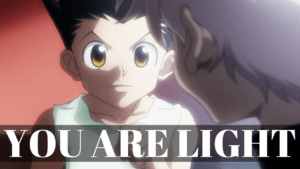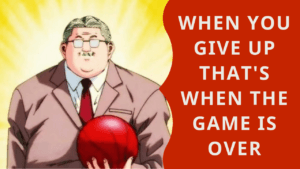Let’s learn Japanese with Muska’s quote from Castle in the Sky (Tenkuu no shiro Laputa).
CONTENTS
Video
Muska’s Quote
Japanese: 見ろ!人がゴミのようだ!
Romaji: miro! hito ga gomi no yō da!
English: Look! The people are like rubbish!
Analysis
見ろ is the imperative form of 見る meaning “look”. This form is used to give an order or command which you rarely hear in ordinary conversation because it sounds quite rude. However, it is used in road signs, slogans or notices. For example, 止まれ meaning “Stop”, 危険!スピード落とせ meaning “Dangerous! Reduce speed”. And for the examples of the negative imperative form when you forbid someone to do something, さわるな危険! meaning “Do not touch. Dangerous” ゴミを捨てるな! meaning “Do not throw rubbish”.
人 means “people”.
This が particle is used to describe a scene that you are looking at right now. For example, when you see the beautiful moon in the night sky, you will say 月がきれいだ meaning “the moon is beautiful”. In this case, 月 is the moon you are just looking at right now. But if you say 月はきれいだ, you are just stating the fact that the moon in general is beautiful so you’re not talking about the specific moon that you are looking at.
Now let’s try making a sentence. You see a frog singing and you will say “A frog is singing!” so let’s change it into Japanese. Think about which particle you should use. – The answer is カエルが歌っている. In this sentence, が is used because you are describing the scene that you are looking at right now. And your realistic friend will say “That’s crazy! Frogs don’t sing”. How would she say this in Japanese? – The answer is そんな馬鹿な!カエルは歌わない. In this case は is used because she is saying “In general frogs don’t sing so it’s impossible”.
ゴミ means “rubbish”. It’s often written in katakana even though it’s a word of Japanese origin. The reason is that its kanji is not included in the jōyō kanji list, which means the kanji of ゴミ is not officially approved to use by the Japanese Ministry of Education. So it’s actually supposed to be written in hiragana but in order to differentiate from other hiragana, many people write it in katakana so that it’s easier to read in a sentence.
Noun + the の particle + よう means “like” or “similar to something”. You can also say みたい instead of のよう which is more colloquial and casual.
だ makes a sentence declarative. In real conversation, it’s usually used with the sentence ending particle such as よ and ね.
Examples
が (used to describe a scene that you are looking at right now)
あ、子供が転んだ。
a, kodomo ga koronda.
Oh, a child fell over.
見て、きれいな星がたくさん出てるよ。
mite, kirei na hoshi ga takusan deteru yo.
Look, lots of beautiful stars are out.
げ!携帯の充電が切れそう。
ge! keitai no jūden ga kiresō.
Crap! My mobile phone battery is about to die.
Other words often written in Katakana because it’s not included in the jōyō kanji list
このカバンはいくらですか?
kono kaban wa ikura desu ka?
How much is this bag?
ここでケンカしないでください。
koko de kenka shinai de kudasai.
Please don’t fight here.
Noun + のよう/みたい
蝶のように舞い、蜂のように刺す。
chō no yō ni mai, hachi no yō ni sasu.
Float like a butterfly, sting like a bee.
お姉さんにそっくりだね。双子みたい!
onēsan ni sokkuri dane. futago mitai!
You are indentical to your sister. Like twins!
まるで + Noun + のよう(みたい) = JUST like …
日本に行けるなんて、まるで夢みたい!
nihon ni ikeru nante, marude yume mitai!
It’s just like a dream that I can go to Japan!
まるで写真のように緻密な絵ですね。
marude shashin no yō ni chimitsu na e desu ne.
It’s a detailed drawing just like a picture.
Support Easy Peasy Japanesey
If you enjoy our content, please consider supporting Easy Peasy Japanesey. Your support will help keep us going. Thanks for all your support!


